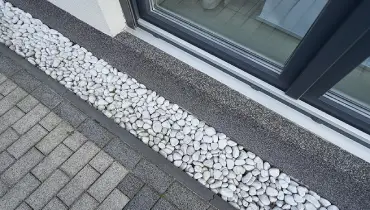
Considering a basement waterproofing system? Rainbow Restoration highlights key benefits and considerations:
|
Is your basement wet to the touch or does it feel damp? Do you walk downstairs to discover puddles, or flooding? Wet basements can lead to serious mold and mildew issues, not to mention structural damage. That’s why if you’ve answered “yes” to any of those questions, it’s time to look for a solution to your wet basement woes.
There are several basement-waterproofing techniques – but which is right for your home and budget? Keep reading to learn more about popular basement waterproofing solutions.
Professionally Installed Basement Waterproofing Systems
First, let’s look at the two main types of professionally installed basement waterproofing systems available to homeowners: 1) exterior foundation sealing systems and 2) interior basement waterproofing systems.
Exterior Basement Waterproofing Systems
Exterior basement waterproofing systems are applied to the exterior of a home’s foundation. Common methods include:
- Cement waterproofing application
This process requires the application of a cement coating onto the exterior of a home’s basement or crawl space, effectively sealing the foundation. Depending on the location and extent of the leak, this process may require excavation of the foundation. Relatively affordable, cement waterproofing may be impacted over time as the foundation settles.
- Installation of a waterproofing membrane
One of the most reliable sources of waterproofing, this process requires excavation around the entirety of a home’s foundation for the installation of a waterproof barrier attached to the exterior of the basement or crawl space. This method is one of the most successful, but also one of the most expensive techniques used for basement waterproofing
- Exterior weeping tile or French drain installation
Not tiles at all, this type of waterproofing system is a series of pipes installed adjacent to the foundation. These pipes contain small holes that collect and carry groundwater away from a home’s foundation. This method also requires some excavation around impacted areas of the foundation of the home.
Interior Basement Waterproofing Systems
Interior basement waterproofing systems are installed inside a home’s basement or crawl space. Commercially available interior basement waterproofing systems include:
- Interior foundation coatings
A variety of interior foundation coatings are available on the market to seal a basement from leaks and foundation weeping. These coatings may be applied with a brush or with a paint sprayer.
- Concrete and crack sealers
Similar to cement waterproofing, concrete crack sealant may be applied to the interior of a home’s basement or crawl space to prevent water from coming in from a weak spot in the foundation.
- Water vapor barriers
In some cases, it may be possible to install water or vapor barriers on the interior walls and floor of a home’s basement or crawl space. A vapor barrier is a type of rubberized board or mat that prevents water from seeping into a basement.
The systems listed above vary widely in application, technique and cost. Depending on the construction of your home, the location of your home, your budget and the amount of water currently making its way into your basement, any one of these systems or a combination of systems may be right for your home.
Consult a basement-waterproofing expert before you choose the system that’s right for you.
What About DIY Basement Waterproofing Systems?
Several of the basement waterproofing systems listed above, including interior coatings and water vapor barriers, could be installed by an intrepid homeowner. However, their effectiveness cannot be guaranteed. As a property owner, it’s always wise to hire a professional to install your basement waterproofing system. However, there are steps you can take yourself to prevent water from entering your home.
These include:
- Keeping gutters clean and free of debris.
- Routing gutters far away from the foundation of a home.
- Keeping landscaping (trees, shrubs) away from the foundation of a home.
- Ensuring exterior faucets are turned off after each use.
- Installing a sump pump in your basement.
Choose Professional Basement Waterproofing Systems for Long-term Success
The choice between professional and DIY basement waterproofing is ultimately up to you. If you find yourself frequently dealing with basement flooding, weeping basement walls or damaged belongings, we recommend working with a reputable handyman or basement waterproofing company to waterproof your basement once and for all.
A local provider will be able to help you determine which solution is best for your household.
If you opt to try a DIY solution first, be sure to follow the manufacturer’s instructions for best results. Combining any of these solutions with landscaping and maintenance will help keep your basement dry for years to come!
Choose Rainbow Restoration for Professional Water Damage Restoration Services
Where there is dampness, there is likely damage in the form of a leak, structural damage or mold and mildew. Before you waterproof your basement, make sure it’s damage-free first with help from the remediation experts at your local Rainbow Restoration. Call or request an estimate online to get started.
